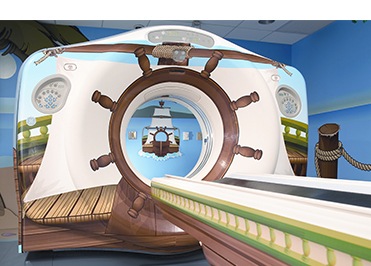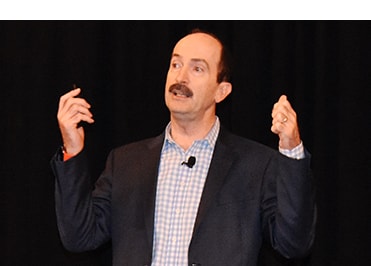To Enhance the Customer Experience, Design Technology with Users in Mind
Empathy, experimentation and storytelling are key elements of human-centric design.

- by Phil Goldstein
- Editor |
GE Healthcare realized it had an issue with its MRI machines when it learned that 80 percent of pediatric patients needed to be anesthetized to undergo MRI scans. If the vast majority of your customers are so afraid of your product that they have to be unconscious to endure it, you may want to rethink your design, said Tom Kelley, general manager of IDEO, an international design and consulting firm.
GE reimagined its MRI machines with the GE Adventure Series, which makes them look like “a ride at Disneyland,” such as a pirate ship or a rocket, Kelley said. The strategy worked: The rates of anesthesia for pediatric MRI patients dropped to less than 10 percent.
GE was able to radically change its customers’ experience by embracing empathy and altering how customers interacted with its technology, a lesson all organizations, large and small, can take to heart, said Kelley during a keynote speech at the CDW summit, “Transforming the Customer Experience with Digital Modernization,” held in New Orleans in September.
Kelley laid out three key design principles that can enhance the customer experience. Organizations, he said, need to make their technology human-centric, experiment continuously to determine how customers want to use technology and tell a simple story to their customers.

We now believe that stories are how you make your data come to life.
Tom Kelley, General Manager, IDEO

Make Technology Human-Centric
A critical element to transforming the customer experience is to design products and services with the customer in mind. That may seem obvious, but it’s often difficult to achieve.
Kelley noted that GE did not change the underlying technology of its MRI machines. The company instead altered the customer experience. GE “saw a problem that no one else was really trying to solve” and “solved it really well,” he added.
That approach can be applied to many aspects of technology design. Evan Carl, general manager of North America partnerships at Kony, which helps organizations design enterprise mobile applications, said that in today’s digital world, many manufacturing companies want to “build a closer connection” with their end customers.
At the summit, Carl noted that companies can use mobile technology to improve their relationships with customers. He cited KMC Controls, which makes commercial-grade industrial controls for HVAC and building automation systems. KMC enlisted Kony to improve the setup process for one of the company’s devices, which was “pretty ugly” and complicated, according to Carl.
Kony built an app for KMC that allows customers to automatically set up one of the devices simply by placing a smartphone on top of the product’s box.
“They found that there was a 75 percent reduction in time on the front end” to set up the devices, Carl said. That enhances the customer experience and delivers a more pleasant interaction with KMC, he added.
47%
Percentage of customers who say they would delete a frustrating mobile application if it does not provide customer support
Source: Radius Global Market Research, 2017
Experiment Continuously
Kelley noted that by continuously revising an idea and incorporating customer feedback throughout an experimental or testing stage, organizations can more closely align their products and services to how customers want to use them. This can transform the customer experience by reducing user frustration and giving customers the features they actually want.
He highlighted Ankit Gupta and Akshay Kothari, creators of the news app Pulse, as designers who used continuous experimentation to achieve technology success. Gupta and Kothari designed Pulse for Apple’s iPad after the first version of the tablet came out. Initially, the app was so messy it was almost unusable. After a few weeks of tinkering, test customers found the app so useful that they wondered if it came installed on every iPad.
Gupta and Kothari told Kelley they were making 100 updates to their software every day as a result of interactions with customers. They made more than 1,000 revisions to their software before they released 1.0 and got customers signed up. However, they were not prepared when former Apple CEO Steve Jobs ran the Pulse app while displaying the new iPad at the company’s Worldwide Developers Conference in 2010. Eventually Pulse got 30 million customers, and in 2013, LinkedIn acquired it for $90 million.
The success came from all the prototypes Gupta and Kothari made. “They did more experiments than anyone,” Kelley said. By experimenting and testing constantly, organizations can figure out more quickly how their customers want to use their services, and then design features and functionality around those desires. In the end, this process increases customer satisfaction because organizations are giving customers what they want.
What's your message that you want people to listen to and remember and tell their colleagues? If you find your story, it will carry your message.
—Tom Kelley
Tell a Story to Customers
The third key to transforming the customer experience is the ability to “leverage the power of storytelling” to enhance the experience. A key element of stories, he said, is to make them simple: “What is the distilled essence of your story?”
The ability to tell stories to customers in a simple way allows organizations to convey their core values and the benefits of their products more easily. That, in turn, gives customers a greater appreciation for what those benefits are. “What's your message that you want people to listen to and remember and tell their colleagues?” Kelley said. “If you find your story, it will carry your message.”
When Kelley joined IDEO, it seemed to him that most of the company’s employees were engineers. “We thought that there’s data and there’s stories, and stories are only useful when you’ve got no data at all. Also known as bull,” he said. “We flipped 180 degrees, and we now believe that stories are how you make your data come to life.”
At Apple, simplicity in design is a key value, along with surprising and delighting customers. These values permeate Apple culture, including how sales associates interact with customers, explains one Apple executive.
Two million sales associates worldwide at companies such as CDW, AT&T, Best Buy and Verizon sell Apple products even though they are not Apple employees. Partner sales associates are responsible for explaining how products work and engaging with customers in a way that represents the Apple brand effectively. Apple’s SEED app provides partner sales associates with technical and sales resources, news and tips about Apple products.
“We wanted them, in a down moment, when there were no customers on the floor, to be able to grab the app and learn something in 60 seconds and then have a customer approach them and maybe weave that right into their conversation,” according to the Apple executive.
The native iOS app gives Apple a way to efficiently deliver up-to-date product information to its retail partners. In turn, those sales associates can use that information to tell a simpler, more effective story to customers about Apple’s products. They also can answer customers’ questions more easily, which improves the customer experience.
The app recently passed a billion minutes of use, even though it’s only been out for about two years. “So, it’s huge scale. But when we solved for it, we were thinking very much about a group of customers that were going to be the consumers and the impact that those customers and salespeople would have upon the end customers,” the Apple executive said. “I think it's a good proxy for the type of work you should be thinking about relative to customer experiences.”
The Impact of Apps
Many people use mobile applications every day, but few apps have the power to save lives. Apple knows that some of them can.
During the CDW Transforming the Customer Experience summit, an Apple executive recounted how Network Rail, the organization responsible for running the train system in the United Kingdom, used a mobile app to greatly improve rail safety.
Network Rail has 14,000 maintenance workers that service the U.K.’s rail infrastructure, including tracks and trains. In the past, when a conductor driving a train noticed something on the tracks that needed to be repaired — such as a light at a signal, a physical bar at a gate, or anything that could be a safety hazard — he or she would note it on a piece of paper on a clipboard. When the train pulled into a station, a runner would grab the piece of paper, which would be turned into a work order.
However, sometimes it would be difficult to decipher a train conductor’s scribbling, and maintenance workers would often be dispatched without the proper equipment to make the right repair.
National Rail shifted to an app that allows conductors to take a picture of a problem they spot or use GPS coordinates to indicate the precise location of the issue. Then, a conductor can use the app to quickly submit a report or use a voice feature to record comments about what he or she saw. The information is captured in real time and immediately sent to start a work order.
“What now happens is, not only do you get more efficiency in how those workers are dispatched, but you also get, potentially, a significant safety hazard reduced, like a light out in a signal,” the Apple executive said. “It may not seem like a big deal, but if a train goes through a red signal, it could be catastrophic.”
Scanner photographs courtesy of GE
Explore Our Featured Partners

Develop a customer-focused approach to IT that drives engagement and improves the customer experience.
MKT22373